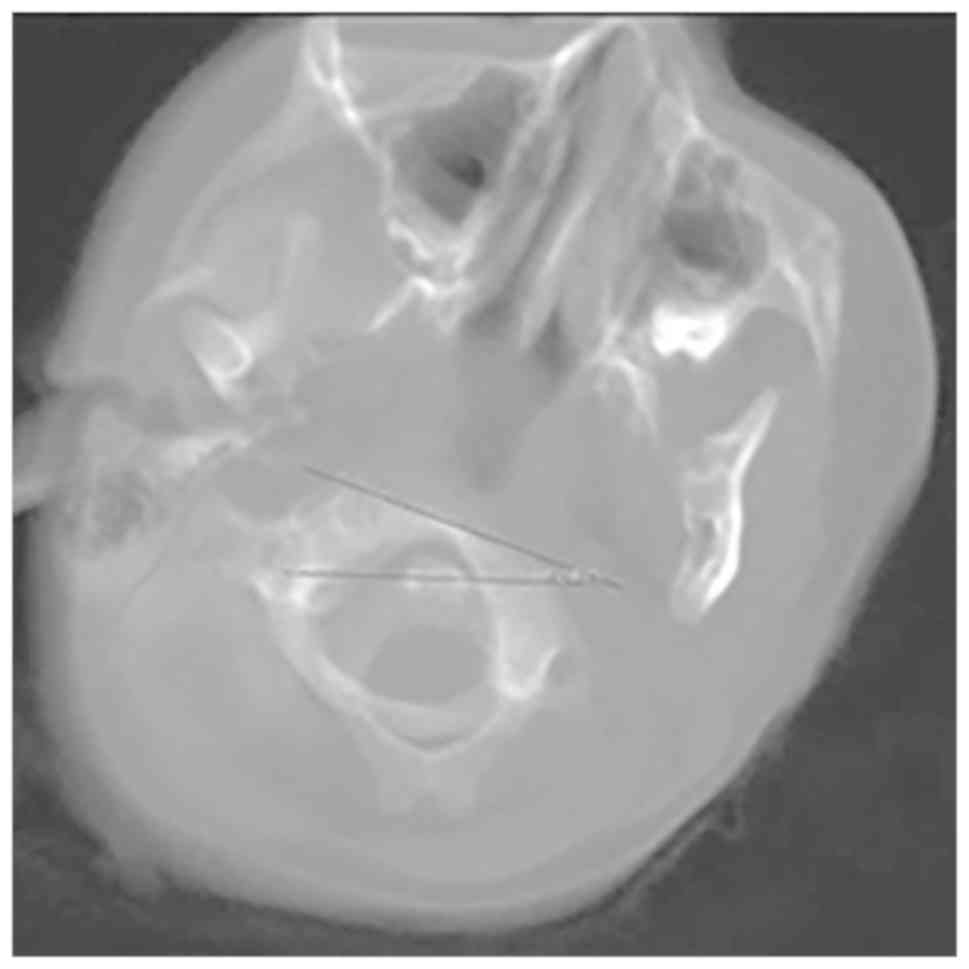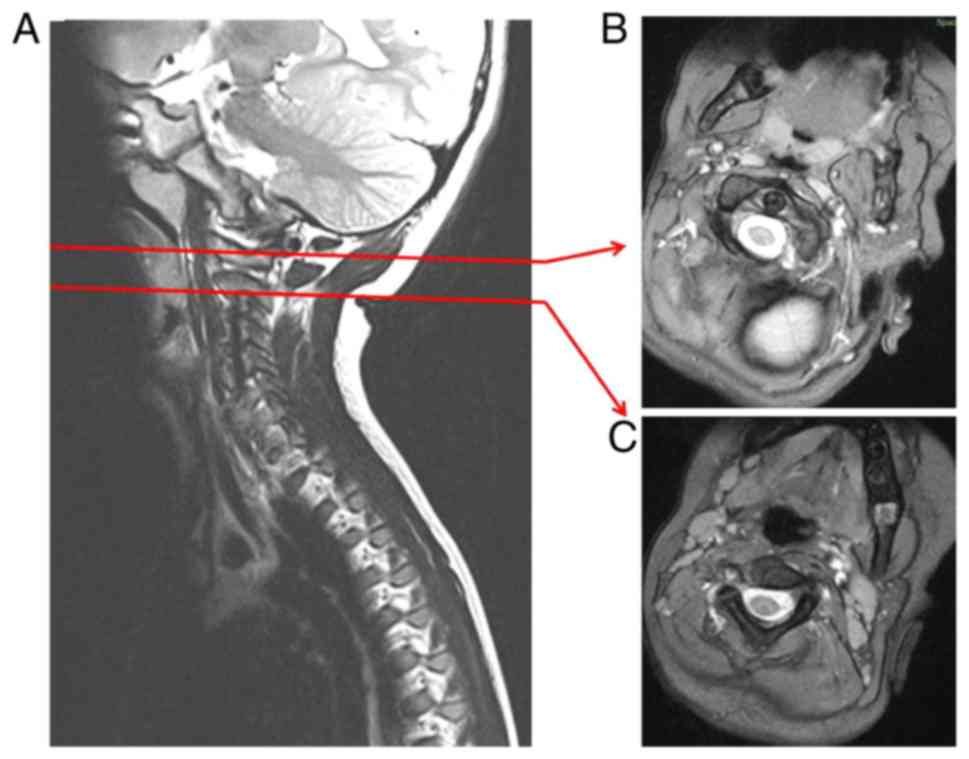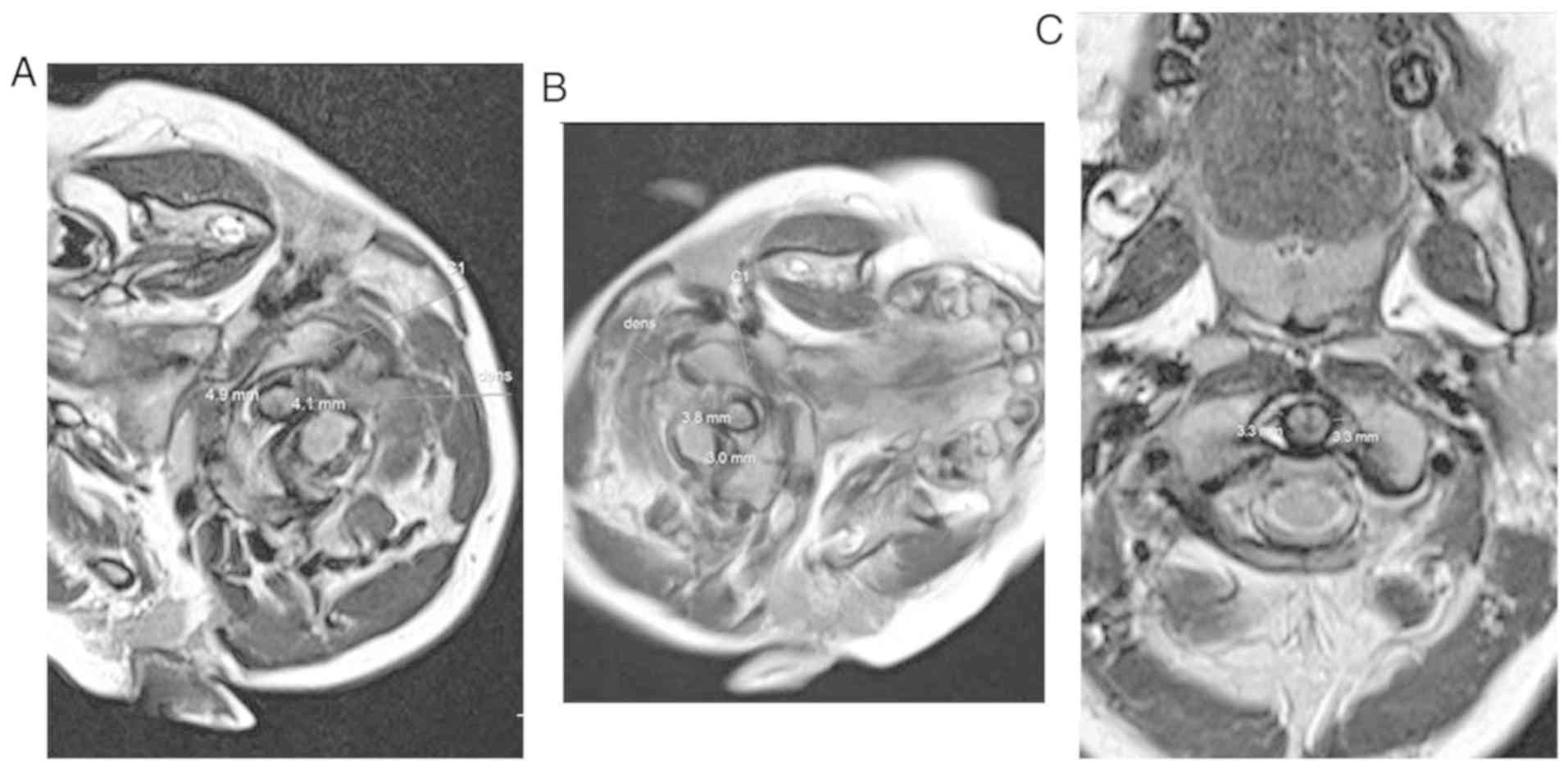|
1
|
Maheshwaran S, Sgouros S, Jeyapalan K,
Chapman S, Chandy J and Flint G: Imaging of childhood torticollis
due to atlanto-axial rotatory fixation. Child Nerv Sys. 11:667–671.
1995. View Article : Google Scholar
|
|
2
|
Fielding JW and Hawkins RJ: Atlanto-axial
rotatory fixation. (Fixed rotatory subluxation of the atlanto-axial
joint). J Bone Joint Surg Am. 59:37–44. 1977. View Article : Google Scholar : PubMed/NCBI
|
|
3
|
Schwarz N: The fate of missed
atlanto-axial rotatory subluxation in children. Arch Orthop Trauma
Surg. 117:288–289. 1998. View Article : Google Scholar : PubMed/NCBI
|
|
4
|
Tauchi R, Imagama S, Kanemura T, Yoshihara
H, Sato K, Deguchi M, Kamiya M and Ishiguro N: The treatment of
refractory atlanto-axial rotatory fixation using a halo vest:
Results of a case series involving seven children. J Bone Joint
Surg Br. 93:1084–1087. 2011. View Article : Google Scholar : PubMed/NCBI
|
|
5
|
Osiro S, Tiwari KJ, Matusz P, Gielecki J,
Tubbs RS and Loukas M: Grisel's syndrome: A comprehensive review
with focus on pathogenesis, natural history, and current treatment
options. Child Nerv Syst. 28:821–825. 2012. View Article : Google Scholar
|
|
6
|
Hicazi A, Acaroglu E, Alanay A, Yazici M
and Surat A: Atlantoaxial rotatory fixation-subluxation revisited:
A computed tomographic analysis of acute torticollis in pediatric
patients. Spine (Phila Pa 1976). 27:2771–2775. 2002. View Article : Google Scholar : PubMed/NCBI
|
|
7
|
Alanay A, Hicazi A, Acaroglu E, Yazici M,
Aksoy C, Cila A, Akalan N and Surat A: Reliability and necessity of
dynamic computerized tomography in diagnosis of atlantoaxial
rotatory subluxation. J Pediatr Orthop. 22:763–765. 2002.
View Article : Google Scholar : PubMed/NCBI
|
|
8
|
Johnson DP and Fergusson CM: Early
diagnosis of atlanto-axial rotatory fixation. J Bone Joint Surg Br.
68:698–701. 1986. View Article : Google Scholar : PubMed/NCBI
|
|
9
|
Haque S, Bilal Shafi BB and Kaleem M:
Imaging of torticollis in children. Radiographics. 32:557–571.
2012. View Article : Google Scholar : PubMed/NCBI
|
|
10
|
Pang D: Atlantoaxial rotatory fixation.
Neurosurgery. 66 (Suppl 3):S161–S183. 2010. View Article : Google Scholar
|
|
11
|
Nicholson P, Higgins T, Forgarty E, Moore
D and Dowling F: Three-dimensional spiral CT scanning in children
with acute torticollis. Int Orthop. 23:47–50. 1999. View Article : Google Scholar : PubMed/NCBI
|
|
12
|
Dagtekin A, Avci E, Kara E, Uzmansel D,
Dagtekin O, Koseoglu A, Talas D and Bagdatoglu C: Posterior cranial
fossa morphometry in symptomatic adult Chiari I malformation
patients: Comparative clinical and anatomical study. Clin Neurol
Neurosurg. 113:399–403. 2011. View Article : Google Scholar : PubMed/NCBI
|
|
13
|
McGuire KJ, Silber J, Flynn JM, Levine M
and Dormans JP: Torticollis in children: Can dynamic computed
tomography help determine severity and treatment. J Pediatr Orthop.
22:766–770. 2002. View Article : Google Scholar : PubMed/NCBI
|
|
14
|
Pang D and Li V: Atlantoaxial rotatory
fixation: Part 2-new diagnostic paradigm and a new classification
based on motion analysis using computed tomographic imaging.
Neurosurgery. 57:941–953. 2005. View Article : Google Scholar : PubMed/NCBI
|
|
15
|
Subach BR, McLaughlin MR, Albright AL and
Pollack IF: Current management of pediatric atlantoaxial rotatory
subluxation. Spine (Phila Pa 1976). 23:2174–2179. 1998. View Article : Google Scholar : PubMed/NCBI
|
|
16
|
Maile S and Slongo T: Atlantoaxial
rotatory subluxation: Realignment and discharge within 48 h. Eur J
Emerg Med. 14:167–169. 2007. View Article : Google Scholar : PubMed/NCBI
|
|
17
|
Barcelos AC, Patriota GC and Netto AU:
Nontraumatic atlantoaxial rotatory subluxation: Grisel syndrome.
Case report and literature review. Global Spine J. 4:179–186. 2014.
View Article : Google Scholar : PubMed/NCBI
|
|
18
|
Beier AD, Vachhrajani S, Bayerl SH,
Aguilar CY, Lamberti-Pasculli M and Drake JM: Rotatory subluxation:
Experience from the hospital for sick children. J Neurosurg
Pediatr. 9:144–148. 2012. View Article : Google Scholar : PubMed/NCBI
|
|
19
|
Mihara H, Onari K, Hachiya M, Toguchi A
and Yamada K: Follow-up study of conservative treatment for
atlantoaxial rotatory displacement. J Spinal Disord. 14:494–499.
2001. View Article : Google Scholar : PubMed/NCBI
|
|
20
|
Mezue W, Taha Z and Bashir E: Fever and
acquired torticollis in hospitalized children. J Laryngol Otol.
116:280–284. 2002. View Article : Google Scholar : PubMed/NCBI
|
|
21
|
Ciftdemir M, Copuroğlu C, Ozcan M, Ulusam
AO and Yalnız E: Non-operative treatment in children and
adolescents with atlantoaxial rotatory subluxation. Balkan Med J.
29:277–280. 2012.PubMed/NCBI
|
|
22
|
Deichmueller C and Welkoborsky H: Grisel's
syndrome-a rare complication following ‘small’ operations and
infections in the ENT region. Eur Arch Otorhinolaryngol.
267:1467–1473. 2010. View Article : Google Scholar : PubMed/NCBI
|
|
23
|
Lee SC, Lui TN and Lee ST: Atlantoaxial
rotatory subluxation in skeletally immature patients. Br J
Neurosurg. 16:154–157. 2002. View Article : Google Scholar : PubMed/NCBI
|
|
24
|
Rahimi SY, Stevens EA, Yeh DJ, Flannery
AM, Choudhri HF and Lee MR: Treatment of atlantoaxial instability
in pediatric patients. Neurosurg Focus. 15:ECP12003. View Article : Google Scholar : PubMed/NCBI
|
|
25
|
Been HD, Kerkhoffs GM and Maas M:
Suspected atlantoaxial rotatory fixation-subluxation: The value of
multidetector computed tomography scanning under general
anesthesia. Spine (Phila Pa 1976). 32:E163–E167. 2007. View Article : Google Scholar : PubMed/NCBI
|
|
26
|
Fernández Cornejo VJ, Martínez-Lage JF,
Piqueras C, Gelabert A and Poza M: Inflammatory atlanto-axial
subluxation (Grisel's syndrome) in children: Clinical diagnosis and
management. Childs Nerv Syst. 19:342–347. 2003. View Article : Google Scholar : PubMed/NCBI
|
|
27
|
Holcomb JD, Jaffe DM, Greinwald JH Jr,
Bauman NM and Smith RJ: Nontraumatic atlantoaxial rotary
subluxation in the pediatric otolaryngology patient: A report of
four cases. Ann Otol Rhinol Laryngol. 110:1137–1140. 2001.
View Article : Google Scholar : PubMed/NCBI
|
|
28
|
Martinez-Lage J, Martinez Perez M,
Fernandez Cornejo V and Poza M: Atlanto-axial rotatory subluxation
in children: Early management. Acta Neurochir (Wien).
143:1223–1228. 2001. View Article : Google Scholar : PubMed/NCBI
|
|
29
|
Ortiz GL, Pratts I and Ramos E: Grisel's
syndrome: An unusual cause of torticollis. J Pediatr Rehabil Med:.
6:175–180. 2013.PubMed/NCBI
|
|
30
|
Muñiz AE and Belfer RA: Atlantoaxial
rotary subluxation in children. Pediatr Emerg Care. 15:25–29. 1999.
View Article : Google Scholar : PubMed/NCBI
|
|
31
|
Meek M, Hermens R and Robinson P: La
maladie de Grisel: Spontaneous atlantoaxial subluxation. Cleft
Palate Craniofac J. 38:268–270. 2001. View Article : Google Scholar : PubMed/NCBI
|
|
32
|
Galer C, Holbrook E, Treves J and Leopold
D: Grisel's syndrome: A case report and review of the literature.
Int J Pediatr Otorhinolaryngol. 69:1689–1692. 2005. View Article : Google Scholar : PubMed/NCBI
|
|
33
|
Sobolewski BA, Mittiga MR and Reed JL:
Atlantoaxial rotary subluxation after minor trauma. Pediatr Emerg
Care. 24:852–856. 2008. View Article : Google Scholar : PubMed/NCBI
|
|
34
|
Pilge H, Prodinger PM, Bürklein D,
Holzapfel BM and Lauen J: Nontraumatic subluxation of the
atlanto-axial joint as rare form of acquired torticollis: Diagnosis
and clinical features of the Grisel's syndrome. Spine (Phila Pa
1976). 36:E747–E751. 2011. View Article : Google Scholar : PubMed/NCBI
|
|
35
|
Wurm G, Aichholzer M and Nussbaumer K:
Acquired torticollis due to Grisel's syndrome: Case report and
follow-up of non-traumatic atlantoaxial rotatory subluxation.
Neuropediatrics. 35:134–138. 2004. View Article : Google Scholar : PubMed/NCBI
|
|
36
|
Missori P, Miscusi M, Paolini S, DiBiasi
C, Finocchi V, Peschillo S and Delfini R: A C1-2 locked facet in a
child with atlantoaxial rotatory fixation: Case report. J
Neurosurg. 103 (Suppl 6):S563–S566. 2005.
|
|
37
|
Gourin CG, Kaper B, Abdu WA and Donegan
JO: Nontraumatic atlanto-axial subluxation after retropharyngeal
cellulitis: Grisel's syndrome. Am J Otolaryngol. 23:60–65. 2002.
View Article : Google Scholar : PubMed/NCBI
|
|
38
|
Park SH, Park SH and Lee SH: Grisel
syndrome: Pathophysiological evidence from magnetic resonance
imaging findings. Ann Rehabil Med. 37:713–716. 2013. View Article : Google Scholar : PubMed/NCBI
|
|
39
|
Sia KJ, Tang IP, Kong CK and Nasriah A:
Grisel's syndrome: A rare complication of tonsillectomy. J Laryngol
Otol. 126:529–531. 2012. View Article : Google Scholar : PubMed/NCBI
|
|
40
|
Tsai SW and Chou CS: A case report of
manipulation under anesthesia of posttraumatic type II
occipital-atlantoaxial rotatory subluxation in a 4-year-old girl. J
Manipulative Physiol Ther. 28:352–355. 2005. View Article : Google Scholar : PubMed/NCBI
|
|
41
|
Pang D and Li V: Atlantoaxial rotatory
fixation: Part 3-a prospective study of the clinical manifestation,
diagnosis, management, and outcome of children with alantoaxial
rotatory fixation. Neurosurgery. 57:954–972. 2005. View Article : Google Scholar : PubMed/NCBI
|
|
42
|
Neal KM and Mohamed AS: Atlantoaxial
rotatory subluxation in children. J Am Acad Orthop Surg.
23:382–392. 2015. View Article : Google Scholar : PubMed/NCBI
|
|
43
|
Li V and Pang D: Atlantoaxial rotatory
fixation. Pang D.: Disorders of the Pediatric Spine (New York).
Raven Press. 531–553. 1995.
|

















